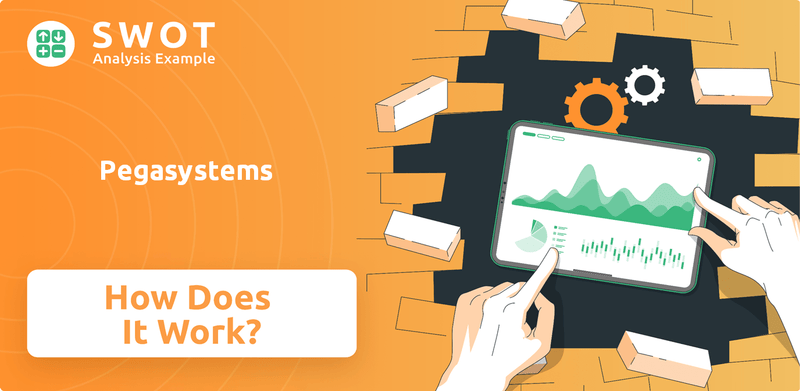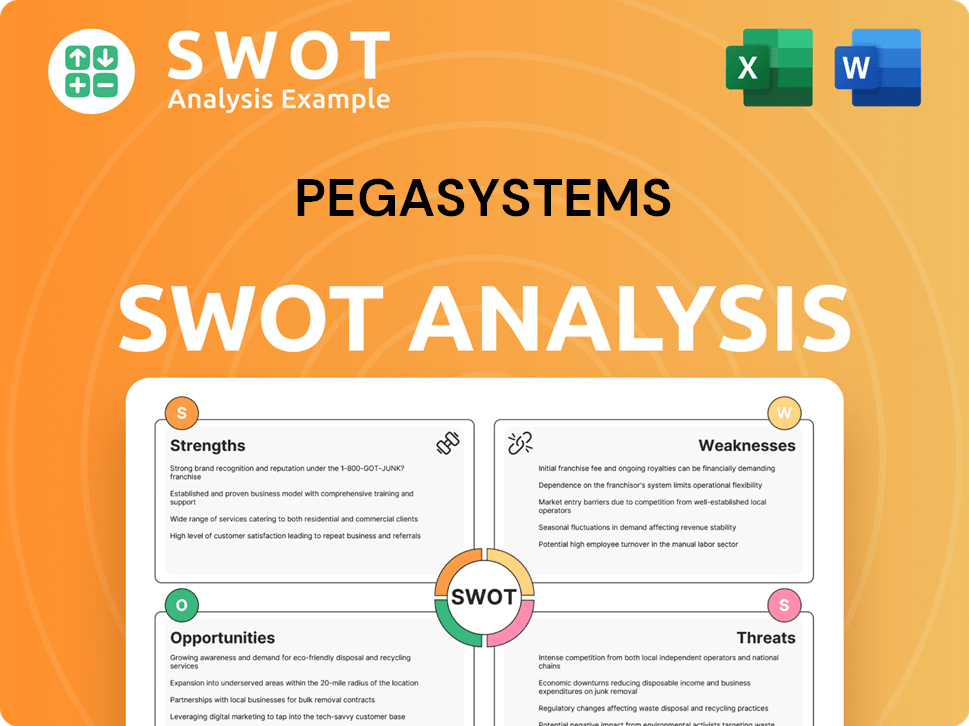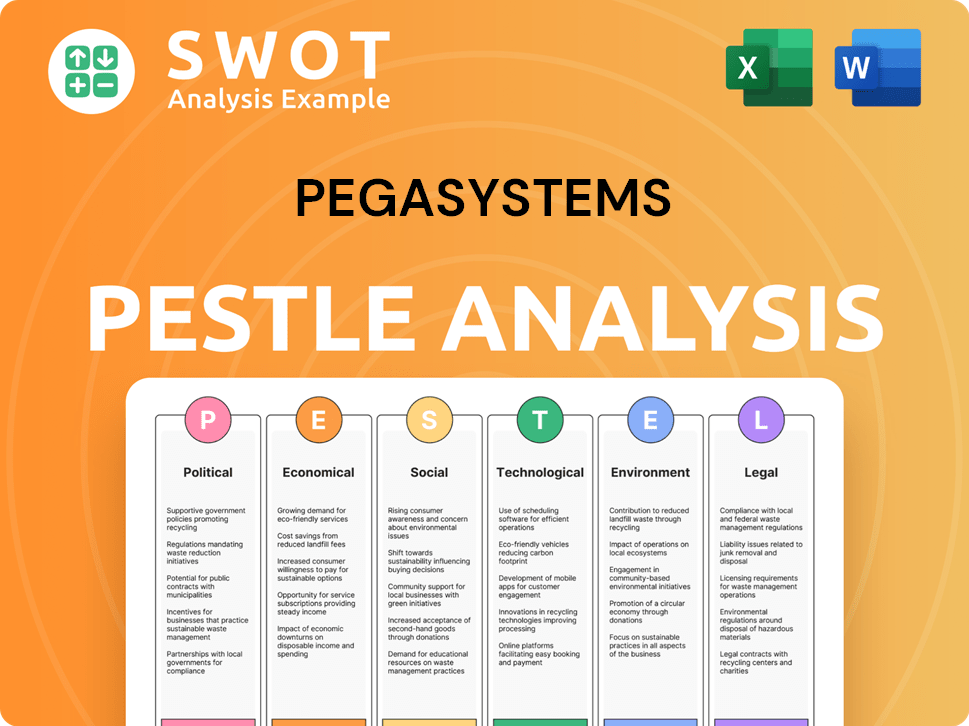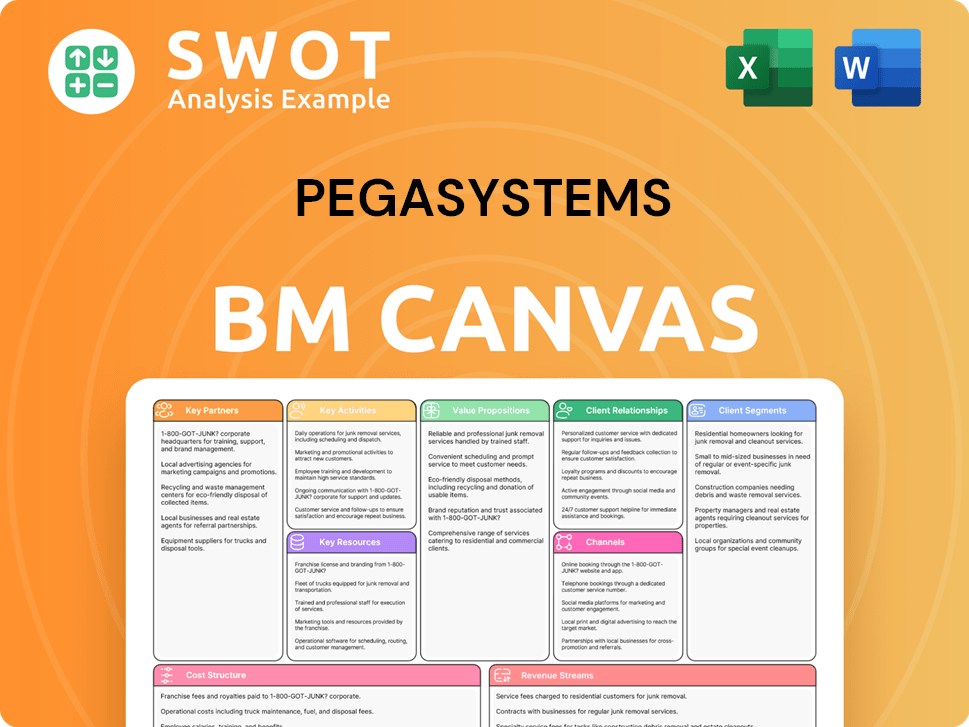Pegasystems Bundle
Decoding Pegasystems: How Does It Thrive in the Digital Age?
Pegasystems, a titan in the enterprise software realm, is revolutionizing how businesses operate. Known for its innovative Pegasystems SWOT Analysis, the company's Pega Platform empowers organizations to streamline complex processes and elevate customer experiences. But how does this technology giant actually function, and what drives its impressive growth?

Understanding the inner workings of Pegasystems, from its Pega software solutions to its strategic use of AI and automation, is key to grasping the future of business. This article will explore the core of Pega's operations, its impact on various industries like financial services and healthcare, and how it continues to adapt in a market demanding efficiency and data-driven decisions. Whether you're curious about Pega applications, Pega BPM, or Pega cloud architecture, this analysis offers actionable insights.
What Are the Key Operations Driving Pegasystems’s Success?
Pegasystems (Pega) delivers value through its unified Pega Platform, which serves as the foundation for its suite of applications. The platform allows organizations to rapidly build and deploy sophisticated business applications without extensive coding. This approach caters to customer segments across large enterprises in sectors like financial services, healthcare, insurance, government, and communications. Pega's core products include Pega Customer Service, Pega Sales Automation, Pega Marketing, and Pega Process AI.
These applications are designed to automate workflows, personalize customer interactions, and optimize business processes. The operational processes supporting these offerings revolve around technology development, cloud infrastructure management, and a global sales and support network. Pega's low-code development environment enables businesses to quickly adapt to changing market conditions and regulatory requirements. The company's supply chain primarily involves software development and intellectual property, with distribution largely through direct sales and a network of strategic partners.
A key differentiator for Pega is its deep integration of AI and machine learning capabilities directly into its platform. This integration enables intelligent automation and real-time decision-making. This translates into significant customer benefits, such as improved operational efficiency, enhanced customer satisfaction, and accelerated digital transformation initiatives. This approach sets Pega apart from competitors that offer more fragmented or less intelligent automation solutions. For more insights into their strategic approach, consider reading about the Growth Strategy of Pegasystems.
Pega's core operations center on software development, cloud infrastructure, and a global sales and support network. The company focuses on creating and maintaining its Pega Platform and associated applications. This includes continuous improvement of its low-code development environment and integration of AI capabilities.
Pega offers a unified platform for customer engagement and operational excellence. Its value lies in enabling rapid application development, automating workflows, and personalizing customer interactions. This results in improved efficiency, enhanced customer satisfaction, and accelerated digital transformation for its clients.
Pega's main products include Pega Customer Service, Pega Sales Automation, Pega Marketing, and Pega Process AI. These solutions are designed to address specific business needs, from managing customer interactions to automating sales processes and optimizing marketing campaigns. The Pega platform supports these diverse applications.
Pega targets large enterprises in industries such as financial services, healthcare, insurance, government, and communications. These sectors benefit from Pega's ability to streamline operations and improve customer experiences. The company's solutions are tailored to meet the specific needs of these industries.
Pega differentiates itself through its unified platform, low-code development, and deep AI integration. This approach allows for rapid application development and intelligent automation, leading to significant customer benefits. The company's focus on customer engagement and operational excellence provides a strong value proposition.
- Unified Platform: Provides a single platform for various business applications.
- Low-Code Development: Enables rapid application development and deployment.
- AI Integration: Enhances automation and decision-making capabilities.
- Customer-Centric Solutions: Focuses on improving customer experiences and operational efficiency.
Pegasystems SWOT Analysis
- Complete SWOT Breakdown
- Fully Customizable
- Editable in Excel & Word
- Professional Formatting
- Investor-Ready Format

How Does Pegasystems Make Money?
Pegasystems, often referred to as Pega, primarily generates revenue through its subscription-based software licenses and related services. The company has strategically shifted towards a cloud-first, recurring revenue model, significantly boosting its Annual Recurring Revenue (ARR). This shift is a core element of its financial strategy, driving long-term value and stability.
The company's financial model is built on recurring revenue streams, with a strong emphasis on customer retention and expansion. This approach supports sustainable growth and allows for predictable financial performance. In its Q4 2024 earnings, Pegasystems demonstrated the success of this transition, reporting an increase in its cloud ARR, highlighting the effectiveness of its cloud-first strategy.
Beyond subscriptions, Pegasystems also generates revenue from professional services, which includes consulting, implementation, and training. These services support the deployment and optimization of its Pega software solutions. While professional services contribute to total revenue, the company prioritizes growing its higher-margin subscription revenue.
The core of Pegasystems' monetization strategy revolves around long-term customer relationships and value realization. The company employs tiered pricing models that are often based on usage, the number of users, or specific functionalities within the Pega platform. This approach ensures that pricing aligns with the value customers receive from the Pega software.
- Subscription Revenue: This is the primary revenue stream, encompassing cloud and term license subscriptions. This segment is the largest portion of total revenue and is a key focus for growth.
- Professional Services: Includes consulting, implementation, and training services. These services support the deployment and optimization of Pega applications.
- Cross-selling: Pegasystems encourages existing customers to adopt additional Pega applications to enhance their digital transformation efforts. This strategy helps expand within existing customer accounts, driving revenue growth.
- Cloud ARR Growth: A key indicator of the success of the cloud-first strategy, as demonstrated in the Q4 2024 earnings.
- Pricing Models: Tiered pricing based on usage, number of users, or specific functionalities.
Pegasystems PESTLE Analysis
- Covers All 6 PESTLE Categories
- No Research Needed – Save Hours of Work
- Built by Experts, Trusted by Consultants
- Instant Download, Ready to Use
- 100% Editable, Fully Customizable

Which Strategic Decisions Have Shaped Pegasystems’s Business Model?
The journey of Pegasystems (Pega) has been marked by significant milestones, strategic shifts, and a focus on maintaining a competitive edge in the rapidly evolving technology landscape. The company's evolution reflects its commitment to innovation and adaptability, particularly in the areas of low-code automation and intelligent decisioning. A look at Brief History of Pegasystems reveals the company's consistent efforts to stay ahead of industry trends.
A key strategic move for Pegasystems has been its transition to a cloud-first, subscription-based business model. This shift has been instrumental in transforming its financial performance. Pegasystems has also continuously integrated advanced AI and machine learning capabilities into its Pega Platform, enhancing its offerings in intelligent automation and real-time decision-making.
The company has faced challenges common to the software industry, including intense competition and the need for continuous innovation. Pegasystems has responded by focusing on its low-code automation capabilities and industry-specific solutions, tailoring its platform to meet the unique needs of different sectors. This strategic focus has helped the company maintain its position in the market.
Pegasystems has achieved several key milestones, including significant product launches and strategic partnerships. These milestones have been crucial in expanding its market reach and enhancing its technological capabilities. The company's growth has been supported by its ability to adapt to changing market demands.
Strategic moves include the shift to a cloud-first, subscription-based model and the integration of AI and machine learning. These moves have aimed to create more predictable revenue streams and improve customer engagement. The company's focus on innovation has allowed it to offer increasingly intelligent automation solutions.
Pegasystems' competitive advantages include strong brand recognition, a comprehensive platform, and deep domain expertise. The company's ability to handle complex business processes and deliver measurable outcomes also contributes to its edge. Pegasystems continues to invest in R&D to maintain its leadership.
Recent developments include a focus on generative AI to enhance the Pega Platform's capabilities. Pegasystems is continually updating its offerings to remain competitive. The company's strategic investments in R&D are designed to improve its platform.
In recent years, Pegasystems has shown consistent growth in its subscription revenue, reflecting the success of its cloud-first strategy. The company's focus on expanding its cloud offerings has resulted in a higher percentage of recurring revenue, providing more financial stability. Pegasystems continues to invest in research and development, with R&D expenses representing a significant portion of its total revenue.
- Subscription revenue has increased, demonstrating the success of its cloud-first strategy.
- The company has a strong focus on customer engagement and retention, reflected in its high customer satisfaction scores.
- Pegasystems has expanded its global presence, serving clients across various industries and geographies.
- The company continues to invest in its Pega Platform, enhancing its capabilities in low-code development, AI, and automation.
Pegasystems Business Model Canvas
- Complete 9-Block Business Model Canvas
- Effortlessly Communicate Your Business Strategy
- Investor-Ready BMC Format
- 100% Editable and Customizable
- Clear and Structured Layout

How Is Pegasystems Positioning Itself for Continued Success?
Pegasystems (Pega) holds a strong position in the enterprise low-code and intelligent automation market. It competes with both large enterprise software vendors and specialized automation providers. The company has a significant market share in its niche, especially for complex case management and customer engagement applications. Pega benefits from strong customer loyalty, driven by the mission-critical nature of its solutions within large organizations.
The company serves customers across North America, Europe, Asia, and other regions, demonstrating a global reach. Key risks include increased competition, potential economic downturns impacting IT spending, and the challenges of managing a large, global customer base. Regulatory changes, particularly concerning data privacy and AI ethics, also pose risks. The company is actively pursuing strategic initiatives to sustain its growth, including enhancing its Pega Platform with advanced AI capabilities and expanding its cloud offerings.
Pega is a leader in low-code platforms and digital process automation. It competes with companies like Salesforce, Microsoft, and ServiceNow. Pega's focus is on complex enterprise applications, especially in industries like financial services and healthcare.
Intense competition from established and emerging players is a primary risk. Economic downturns can affect enterprise IT spending, impacting Pega's revenue. Data privacy regulations and AI ethics present ongoing challenges. The company must continuously innovate to stay ahead.
Pega aims to expand its market penetration, particularly in industries undergoing digital transformation. The company is investing heavily in generative AI, process mining, and intelligent automation. Pega plans to leverage its technological leadership to capture new opportunities.
Pega is enhancing its Pega Platform with advanced AI capabilities. It's expanding its cloud offerings to meet growing demand. The company is also strengthening its go-to-market strategies to reach more customers.
Pega is focused on enhancing its Pega Platform with generative AI and expanding its cloud offerings. The company is also strengthening its go-to-market strategies. This approach is designed to drive sustainable growth and market share expansion.
- Continued investment in generative AI and process mining.
- Expansion of cloud-based solutions to cater to evolving customer needs.
- Strengthening of sales and marketing efforts to reach new markets.
- Focus on industries experiencing significant digital transformation.
Pega's innovation roadmap emphasizes continued investment in generative AI, process mining, and intelligent automation to deliver even greater value to its customers. For example, Pega's focus on low-code development allows businesses to rapidly build and deploy applications, which is a key factor in its competitive advantage. Read more about Pega's Growth Strategy of Pegasystems to understand how the company plans to achieve its goals.
Pegasystems Porter's Five Forces Analysis
- Covers All 5 Competitive Forces in Detail
- Structured for Consultants, Students, and Founders
- 100% Editable in Microsoft Word & Excel
- Instant Digital Download – Use Immediately
- Compatible with Mac & PC – Fully Unlocked

Related Blogs
- What are Mission Vision & Core Values of Pegasystems Company?
- What is Competitive Landscape of Pegasystems Company?
- What is Growth Strategy and Future Prospects of Pegasystems Company?
- What is Sales and Marketing Strategy of Pegasystems Company?
- What is Brief History of Pegasystems Company?
- Who Owns Pegasystems Company?
- What is Customer Demographics and Target Market of Pegasystems Company?
Disclaimer
All information, articles, and product details provided on this website are for general informational and educational purposes only. We do not claim any ownership over, nor do we intend to infringe upon, any trademarks, copyrights, logos, brand names, or other intellectual property mentioned or depicted on this site. Such intellectual property remains the property of its respective owners, and any references here are made solely for identification or informational purposes, without implying any affiliation, endorsement, or partnership.
We make no representations or warranties, express or implied, regarding the accuracy, completeness, or suitability of any content or products presented. Nothing on this website should be construed as legal, tax, investment, financial, medical, or other professional advice. In addition, no part of this site—including articles or product references—constitutes a solicitation, recommendation, endorsement, advertisement, or offer to buy or sell any securities, franchises, or other financial instruments, particularly in jurisdictions where such activity would be unlawful.
All content is of a general nature and may not address the specific circumstances of any individual or entity. It is not a substitute for professional advice or services. Any actions you take based on the information provided here are strictly at your own risk. You accept full responsibility for any decisions or outcomes arising from your use of this website and agree to release us from any liability in connection with your use of, or reliance upon, the content or products found herein.